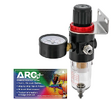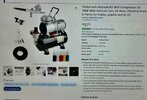Hello all. I'm 66, retired and looking to get back into building models. Last did this sort of thing when I was 14 or so. Back then it was all cars, now it's going to be space and sci-fi stuff.
My question has to do with painting. Back then it was either tiny bottles and small paintbrushes or small spray cans. Results were mixed. Now of course I am aware of Airbrushes and from what I understand they are much better both in terms of the quality of the paint job that can be achieved as well as being more economical from a paint standpoint. I've got zero experience with them and so I don't want to sink too much money into one (yet) until I know I'm up to the task. So, what would you recommend as a good starter model (meaning airbrush model)?
Also, I'm trying to set up a section in my basement to have as my model shop. Does airbrush painting require the same amount of ventilation as it was when using the old spray cans?
Thanks in advance.
My question has to do with painting. Back then it was either tiny bottles and small paintbrushes or small spray cans. Results were mixed. Now of course I am aware of Airbrushes and from what I understand they are much better both in terms of the quality of the paint job that can be achieved as well as being more economical from a paint standpoint. I've got zero experience with them and so I don't want to sink too much money into one (yet) until I know I'm up to the task. So, what would you recommend as a good starter model (meaning airbrush model)?
Also, I'm trying to set up a section in my basement to have as my model shop. Does airbrush painting require the same amount of ventilation as it was when using the old spray cans?
Thanks in advance.


